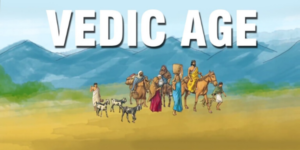Era of Rig Vedic Period: Important Highlights
Understand the Era of Rig Vedic Period
After the decline of Indus valley civilisation around, it is believed that Aryans started to appear India around1500 BC.The region where they first settled in Indian sub-continent was known as the land of seven rivers (Sapta Sindhu).This was the same area where once Harrapan culture flourished.
Aryans spoke the Indo-European language. They seem to have originated near the steppes stretching from southern Russia to central Asia. Primarily they indulge in pastoral herding and secondary occupation was agriculture.
Read more: The Lodi Dynasty Under Delhi Sultanate
Read more: GREEN WALL OF INDIA, VERTICAL GARDEN, INSIGHTS

Division of Vedic Age-
1. Rig Vedic period is the period in which Rig Veda was compiled.
2. Later Vedic period was the period in which other three Vedas ( Yajur, Sam & Atharva) along with their respective Brahmanas, Upanishads and Aranyakas were composed.
What do we mean by word Vedas?
Vedas means to know/ knowledge. It is believed that the Aryans were the founders or creators of the Vedic culture.They had no knowledge about the script and therefore they transmitted their knowledge orally. It is for this reason only that the vedic literature is also known as shruti literature.
Rig Veda
It is the collection of hymns to be recited at the time of sacrificial rites and other rituals. Rig Veda is the oldest book in any Indo-European language and contains the earliest form of all Sanskrit mantras.It consists of 1028 hymns or suktas arranged in 10 books (mandals).It has nearly 10580 verses. Shakalashakha is the only surviving recension of the rig veda.
Vedangas
Vedanga means limbs of the Vedas. They are the supplementary texts which deal with the proper recitation and understanding of the Vedas. But these do not qualify as shruti as they are considered of human origin (not revealed by the gods). Hence it is a part of smriti texts and they were handed down by tradition. Vedangas were compiled during 600 BC. They were written in the form of sutras refers to a style in which ideas are expressed in condensed statements.
Society of early Vedic period
The early Vedic/ Rig Vedic society was a semi-nomadic and a tribal polity. However, it cannot be considered a complete egalitarian society as social division was based on the division of labour and gender.
Important Highlights of Early Vedic Society:
•The rig vedic people were familiar with slavery.
• Aryan tribes were called janas, whose chief was rajan/gopati/gopa (also a protector of cow) and his queen was called mahisi.
• Janas had often conflict with panis because they were deemed as the enemy of aryans who used to hide the cattles of aryans in the forest.
• Vedic god Indra was invoked in order to get back the cattles and the following battles were fought b/w the aryans and panis- govisthi, goshu, gaveshana & gavyat.
Economy of Early Vedic period
• The Rig vedic society was a pastoral society and cattle rearing was their main occupation.
• Niksha was the unit of currency, which was made of gold.
• There was no regular revenue system and the kingdom was maintained by the voluntary tribute (Bali) from ordinary kinsmen and booty won in a battle.
• Gift exchange and redistribution had an economic role. Such exchanges were known as prestation, were not done on an individual level but at the group level.
• The priests received Dakshina and Dana.
• Shifting agriculture was practised and fire was used to burn down forest cover and then the cleared patch of land was sown
Culture and religion of Early Vedic period
• The Rig Veda reflects naturalistic polytheism (similar to primitive animism) as they worshipped the forces of nature
• Yajnas were the mode of worship
• Indra, Agni, Varuna, Soma, Yama, Rudra, Pushan, Marut, Aditi, Usha and Vishnu were the major deities of Rig Vedic period.
• Rigvedic hymns were sung to pacify their deities.
• There were no such places of worship such as temples
• No idol worship was carried
For more such informative articles stay tuned to OWN TV.
